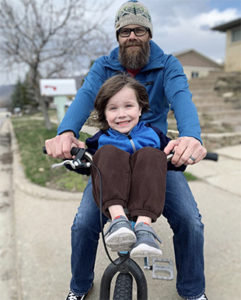 Tim Fuller, Ph.D. is a research scientist with the Sandia National Laboratories where he works on developing finite element codes used in production and in national security-related applications. Additionally, he teaches ME courses at the U from time to time. He has taught five different courses, some multiple times, including Advanced Finite Element Method, Computational Mechanics, and Solid Mechanics.
Tim Fuller, Ph.D. is a research scientist with the Sandia National Laboratories where he works on developing finite element codes used in production and in national security-related applications. Additionally, he teaches ME courses at the U from time to time. He has taught five different courses, some multiple times, including Advanced Finite Element Method, Computational Mechanics, and Solid Mechanics.
Fuller received his Ph.D. in Mechanical Engineering from the University of Utah in 2010. As a graduate student, he studied solid mechanics, with a focus on solid mechanics. Working under Dr. Brannon’s supervision, his research was focused on thermodynamically consistent formulations in finite-deformation loading regimes. His doctoral thesis described the requirement supported
by thermodynamics that certain classes of isotopic materials must have an anisoptropic elastic stiffness.
“I found myself gravitating towards numerical analysis and applied math courses from the Math, Physics, and Computer Science departments,” said Fuller. “However, Continuum Mechanics literally changed the trajectory of my career and led me to where I am now.”
After graduation, Fuller’s work focused on computational models for quasi-brittle materials subjected to high-loading-rate, which led to an NNSA Defense Program Awards of Excellence in 2013 for modeling ferroelectric impact fuzes. He also developed advanced computational models for solid propellants used in NASA’s Space Launch System, as well as other government solid propellant motors.
In 2016, Fuller returned to Utah and resumed working with Sandia National Labs. “My work is split primarily between two completely different fields: computational material modeling and parallel linear algebra,” said Fuller. “Most of the work I do would be unseen by the general public. Lots of work writing lower level mathematics and physics codes.” He also added that while he is reporting to Sandia, the work ends up going to the Department of Energy and other government organizations, where it influences policy decisions.
Additionally, since 2014 Fuller has served as an adjunct faculty member in the Department of Mechanical Engineering. In addition to periodically teaching courses, he has served on several masters and Ph.D. student committees and continues to fill that role. As a Utah alum working at one of the largest Department of Energy research labs, he is in a unique position to provide career opportunities to U students. He has helped students find permanent and temporary positions at Sandia in the form of summer internships, post-doctoral, and full-time staff positions.
“As a student, I would encourage you to get to know your professors: use office hours, participate in class, etc.,” said Fuller. “Also, reach out to
other professionals in fields you are interested in and ask their advice, most will be happy to share it. For many engineers, it is difficult to break
out of their introvert shell (it is for me!) but it is worth the time and effort.”